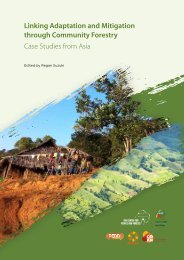Desktop Study on - Regional Climate Change Adaptation ...
Desktop Study on - Regional Climate Change Adaptation ...
Desktop Study on - Regional Climate Change Adaptation ...
You also want an ePaper? Increase the reach of your titles
YUMPU automatically turns print PDFs into web optimized ePapers that Google loves.
Assessment of Capacity Gaps and Needs of South East Asia Countries<br />
in Addressing Impacts, Vulnerability and Adaptati<strong>on</strong> to <strong>Climate</strong> Variability and <strong>Climate</strong> <strong>Change</strong><br />
almost 500 people killed in the devastating floods<br />
in 2000 and 2001 were children (Chaudhry and<br />
Ruysschaert, 2007). As a less<strong>on</strong> learned between the<br />
two disasters, a measure undertaken for reducing<br />
child fatalities was to build new schools that were<br />
flood proof. The problem c<strong>on</strong>tinued, however, since<br />
many of the poorest children were not attending<br />
the school during the flood period, since they had to<br />
work in fishing and agriculture and thus still resulted<br />
to be highly vulnerable. Already after the flood in<br />
2000, day time child care with women volunteers<br />
were established and aid organizati<strong>on</strong>s distributed<br />
boats for means of transports and for fishing. After<br />
the 2001 flood, however, such resp<strong>on</strong>se programs<br />
were developed with a focus <strong>on</strong> the poor people<br />
(Chaudhry and Ruysschaert, 2007).<br />
As a c<strong>on</strong>sequence of the floods in 2000 and 2001,<br />
the Government also launched a program of safe<br />
settlement areas, including the home relocati<strong>on</strong><br />
above flood levels, in order to being able to pass <strong>on</strong><br />
evacuati<strong>on</strong>s, according to the policy slogan `living<br />
with the floods´ (Chaudhry and Ruysschaert, 2007).<br />
Besides children, also women have been c<strong>on</strong>sidered<br />
to be especially vulnerable to natural disasters.<br />
According to Oxfam (2008), women are especially<br />
hit by natural disasters since they often cannot swim<br />
and have limited opportunities for employment<br />
away from home in the case of threatened livelihood<br />
due to destroyed crops. However, women have been<br />
shown to be very effective in the mobilizati<strong>on</strong> of local<br />
involvement and implementati<strong>on</strong> of communitylevel<br />
resp<strong>on</strong>ses. The Oxfam-study also shows that<br />
local level disaster risk management programs, such<br />
as implemented in Quang Tri, are able to significantly<br />
reduce vulnerability to flooding. A recommendati<strong>on</strong><br />
drawn from that is that community-based planning<br />
should be used to scale up to provincial and nati<strong>on</strong>al<br />
resp<strong>on</strong>ses, drawing <strong>on</strong> people’s pers<strong>on</strong>al experiences<br />
at percepti<strong>on</strong>s at local level (Oxfam, 2008).<br />
While the cycl<strong>on</strong>e intensity shows the tendency to<br />
be increasing over time, not <strong>on</strong>ly the vulnerability<br />
of rural communities but also of urban areas has<br />
increased (Chaudhry and Ruysschaert, 2007).<br />
Families that improved their housing through own<br />
efforts run the risk of housing loss and damaging<br />
since they do not apply the rules of a storm resistant<br />
c<strong>on</strong>structi<strong>on</strong>. Also, the urban houses tend to have<br />
very flat roofs that show a high risk of damage<br />
(Chaudhry and Ruysschaert, 2007).<br />
Adaptati<strong>on</strong><br />
For over 1000 years, Viet Nam has been developing<br />
an extensive system of dykes for the physical<br />
protecti<strong>on</strong> from typho<strong>on</strong>s and sea level rise<br />
(Chaudhry and Ruysschaert, 2007). Today, the dyke<br />
system includes 5,000 km of river and 3,000 km of<br />
sea dykes. Building and maintenance of the dykes<br />
used to be d<strong>on</strong>e through collective mobilizati<strong>on</strong>s of<br />
household labor. Nowadays, the collective labour has<br />
been replaced by a tax and hired labor, since betteroff<br />
households were not willing or able to bear the<br />
lost income due to the spent days of labor. There<br />
is the percepti<strong>on</strong> that sea defense infrastructure<br />
overall could be improved due to increased wealth<br />
and infrastructure development in past years, at<br />
least for the better-off households (Chaudhry and<br />
Ruysschaert, 2007).<br />
Besides dykes, another important and highly<br />
effective measure of protecting the coastal z<strong>on</strong>e<br />
from storm surges is coastal mangrove plantati<strong>on</strong>.<br />
Coastal communities with the support of NGOs and<br />
internati<strong>on</strong>al d<strong>on</strong>ors have undertaken successful<br />
projects of mangrove restorati<strong>on</strong> (Chaudhry and<br />
Ruysschaert, 2007).<br />
As a resp<strong>on</strong>se to the increased vulnerability of<br />
housing damages to storm, an initiative supported<br />
by the European Commissi<strong>on</strong> Development<br />
Workshop promotes the applicati<strong>on</strong> of ten principles<br />
for achieving storm resistance in new and existing<br />
housing in Central Viet Nam. The principles include<br />
for instance to build the house with a simple shape,<br />
to choose a locati<strong>on</strong> without full wind or flood force,<br />
and to c<strong>on</strong>struct the roof in an angle of 30° - 45°C<br />
(Chaudhry and Ruysschaert, 2007).<br />
Since vulnerability to climate change is closely linked<br />
to poverty, crucial l<strong>on</strong>g-term adaptati<strong>on</strong> measures<br />
are c<strong>on</strong>sidered necessary to reduce poverty, such as<br />
the diversificati<strong>on</strong> of incomes, respect of comm<strong>on</strong><br />
property rights, and promoti<strong>on</strong> of collective security<br />
(Chaudhry and Ruysschaert, 2007). In an approach<br />
of systematic integrati<strong>on</strong> and mainstreaming, risk<br />
management, poverty alleviati<strong>on</strong> and sustainable<br />
development need to be c<strong>on</strong>sidered in combinati<strong>on</strong><br />
and across all the development sectors in view of<br />
planning for climate change (Oxfam in Viet Nam,<br />
2007).<br />
Besides, a key resp<strong>on</strong>se to climate related disaster<br />
risks is Viet Nam’s development of disaster early<br />
warning systems. Viet Nam has been supported by<br />
UNDP in improving early warning, collecting and<br />
reporting damage and hydrometeorological data,<br />
and providing more readily and widely available<br />
informati<strong>on</strong>. Today, the government is undertaking<br />
efforts to upgrade the disaster early warning<br />
43

















